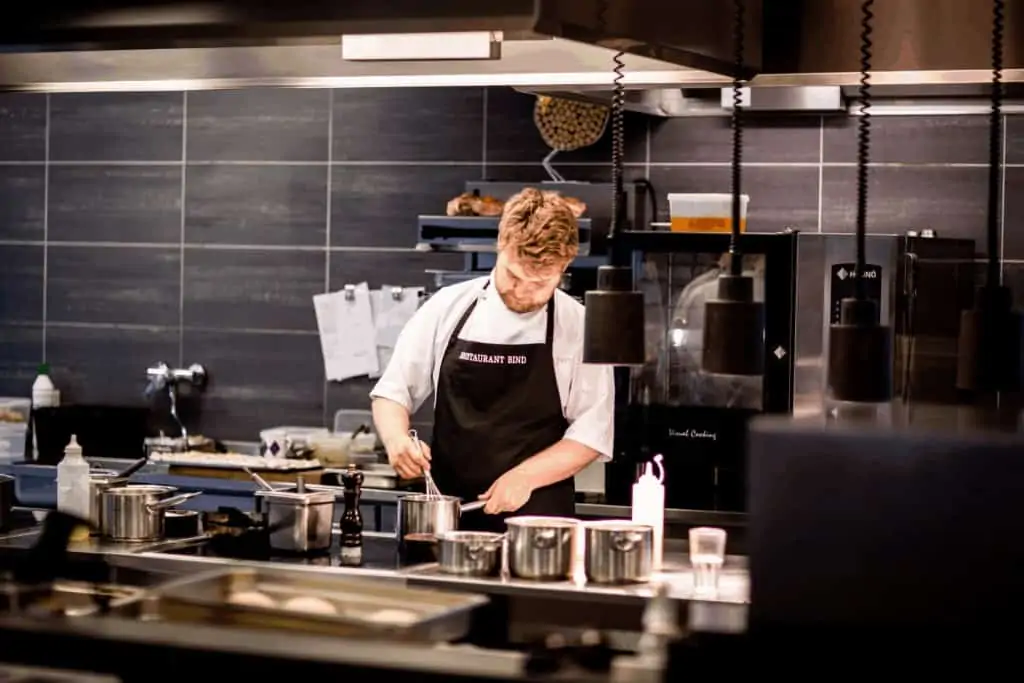A restaurant cannot run in top shape unless you open and close properly. When steps are skipped, everyone feels the effects. Servers are more frazzled, customers are less satisfied, and the kitchen staff is uninspired.
That’s why staying organized and motivated is critical to your restaurant’s success. If you’re wondering how to streamline operations, creating a standard checklist to follow is a great start.
Restaurant Opening and Closing Checklist
A good checklist is important, especially in a fast-paced environment like a restaurant. It helps make sure that no task is overlooked, and that each employee knows what to do in any given situation. It can also reduce forgetfulness and lower the chances of human error.
Restaurant opening and closing checklists ensure that tasks that are crucial for maintaining a clean establishment are always completed. This is especially important in the kitchen, where bacteria can fester and infect food if surfaces are not properly cleaned and sanitised. It can also increase health and safety standards in your venue by ensuring that employees always follow best practice when handling food.
Whether you are using an online checklist tool or simply making a list in a notebook, the key to success is ensuring that each item on the checklist is clearly and concisely written. It is a good idea to involve all your staff in the process of creating the checklist, so that they are aware of what is expected from them.
Front of house staff are responsible for making sure the restaurant is open and ready to receive customers at the start of each shift. This includes preparing tables with menus, condiments, and other items, cleaning and sanitizing all surfaces, and returning seats to their original positions. Back of house staff are responsible for preparing the kitchen for the day, including restocking ingredients and supplies, and making sure that appliances have been turned off.
Making a Checklist
Most restaurants divide staff into three separate business units:
- Front of House (FOH)
- Back of House (BOH)
- Management
When managing a checklist, typically a senior server will maintain the FOH, a general manager will oversee the management checklist, and a kitchen manager or sous chef will handle the BOH check off. While these staff members are not responsible for every task, it is their job to make sure it gets done by everyone. Thus, checklists are typically divided by business units and type of task.
A good checklist is not just something you jot down while grocery shopping, it’s an essential business tool. It gives you an eagle eye view of your operations and helps you stay on track to meet all of your goals. Whether you use a digital management checklist, a restaurant management checklist template you found online or you create your own, the key is to make it work for your specific needs.
Overseeing the managment checklist
When you’re juggling several responsibilities, it can be difficult to keep track of everything that has to get done. Checklists help you organize projects, people, deliverables, deadlines and more. Whether you’re a project manager or a team leader, a well-made checklist can make it easier to stay focused and on task.
Kitchen manager
Keeping the restaurant running smoothly during opening and closing shifts requires careful planning. A restaurant opening and closing checklist is a simple, effective way to ensure that all required tasks are completed. A properly designed checklist will include all the tasks needed to prepare a specific station for opening, shift change or closing, along with boxes that can be checked when each task is complete. A good checklist will also be laminated and affixed to the station, so that it is easy for employees to find and use.
Great general managers (GM) have a knack for seeing the big picture. They can quickly identify what’s most important and advise their teams on what to prioritize. They can also see how a single decision might impact multiple elements of a project, making them less likely to become overwhelmed or over-extended.
These tasks fall within duties that include:
- Cleaning
- Food prep
- Stocking and inventory
- Organization and administration
- Finance
Once created, these lists should be printed out, laminated, and posted in clear view of all staff members in that space.
Our Restaurant Checklist for Opening & Closing
Opening
The opening checklist sets a standard for the day and ensures all staff is prepared for the rush. There is nothing worse than being in the weeds because you missed steps while opening. Here are the tasks to keep you on track:
Front of House
Prep Work and Cleaning
- Turn on the dining room and bar lights.
- Remove chairs and position them around the tables.
- Set up the dining room according to the floor plan.
- Polish glasses and silverware.
- Put out place settings.
- Assemble the soda machine and beer taps.
- Make a pot of coffee and brew a batch of iced tea.
- Cut fruit for drinks and bar garnishes.
- Cut up and set out all food for plate garnishes.
- Set out any sauces needed.
- Make side salads and turn on soups.
- Fill water pitchers.
- Wipe down all menus.
Stocking
- Refill receipt paper.
- Make sure all bathrooms are stocked and clean.
- Roll silverware for shift.
Administration
- Sign in.
- Reference reservation list for notes and special requests.
- Check with kitchen about daily specials or menu changes.
- Flip the “Open” sign or turn the light on.
Safety
- Ensure all tables and chairs are sturdy.
- Check all tray tables and stands are usable.
Finance
- Count money in the register if necessary.
- Make sure you have a “bank” on hand.
Back of House
Prep and Cleaning
- Turn on lights, then hoods, then gas, then grills.
- Turn on the fryers.
- Check and log temps of fridge and freezer units.
- Pull all frozen food needed for prep.
- Fill all ice bins.
- Sanitize and sharpen kitchen tools.
- Wipe all food prep surfaces.
Stocking
- Stock line stations.
- Refill all sauces, dressings, and condiments.
- Chop ingredients for kitchen stations.
Administration
- Manage pre-opening deliveries.
- Report on any short or missing inventory that needs to be 86’d for the day.
Safety
- Check all safety stations and equipment to ensure everything functions properly.
Management
Cleaning
- Check the restaurant floor and BOH to ensure it is service-ready.
- Inspect all equipment is working properly.
- Check the guest bathroom for cleanliness.
- Ensure all menus are wiped down and have the correct information.
Staff Management
- Inspect all employee uniforms and make sure everyone is clocked in.
- Hold a quick staff meeting to go over shift responsibilities.
- Review menu items and specials.
- Staff tasting of new items.
- Review and initial any food prep lists when completed.
Administration
- Evaluate any reports from the night before and set goals.
- Review and plan schedule. Update if needed.
- Approve any shift changes.
Organization
- Answer emails, social media posts, and online reviews.
- Organize incoming deliveries.
- Set up equipment maintenance and repair.
Finance
- Pay bills.
- Answer payroll questions.
- Get any daily deposits ready.
- Establish daily sales goals and quotas.
Safety
- Turn off the alarm, unlock the door, and do a quick sweep of the entire store.
Closing
Closing a restaurant is more challenging because you never know what’s going to happen throughout the day. Therefore, a closing checklist should be thorough and prepare the next shift for success. Here are a few general tasks to add to your own:
Front of House
Cleaning
- Burn all ice and drain out the bins.
- Wipe down all serving trays.
- Clean all tables and chairs. Flip chairs on top of the table.
- Wipe down the bar, including stools.
- Remove all non-stick mats on the floor and put them up.
- Pull up any grating and clean spills underneath.
- Sweep and mop the floor.
- Empty water pitchers.
- Reposition all tables and chairs according to the floor plan.
- Wipe down checkbooks, menus, and POS server stations.
- Empty and clean the coffee and iced tea makers.
- Clean the soda station and beer taps. Soak the spouts and plug the taps.
- Seal open wine bottles.
- Pull spouts from liquor bottles and wipe them down.
- Make sure the guest bathroom is clean.
- Empty all rag buckets and put them up.
- Empty all trash bins and take the trash to the dumpster.
- Shine any glass surfaces and windows.
- Turn off the dining room and bar lights.
Stocking
- Roll silverware.
- Restock the server station and paper goods.
- Replenish all items in the guest bathroom.
- Restock coffee and tea, including filters.
- Refill salt and pepper shakers. Marry condiments.
- Restock and run bar inventory on liquor bottles and mixers.
- Refill all bar garnishes.
- Restock all beer kegs and take inventory.
- Stock all fridges with canned drinks, creamer, etc.
Safety
- Lock all alcohol cabinets.
- Secure all doors and windows.
- Check the walk-in freezer and lock it behind you.
Finance
- Run all end of shift reports.
- Count cash, credit card receipts, coupons, etc.
- Tip out the necessary parties.
- Cash out with management.
Back of House
Cleaning
- Burn all ice and drain out the bins.
- Clean all prep areas and line stations.
- Scrub the flat top.
- Change the fryer oil.
- Wash and sanitize all cooking utensils.
- Load the dishwasher.
- Remove all non-stick mats on the floor and hose them down.
- Pull up any grating and clean spills underneath.
- Sweep and mop the kitchen floor.
- Empty all kitchen trash bins and take out the trash.
- Clean and restock the employee bathroom.
- Makes sure the break room is clean and tidy.
- Empty all rag buckets and put them up.
Stocking
- Consolidate all food containers
- Check inventory and adjust any orders that need it.
- Date and label all food before putting away.
- Restock all line stations.
- Store all perishable foods in the walk-in or freezer.
Organization
- Write out a prep list for tomorrow’s prep cook based on remaining inventory.
- Make sure the walk-in is organized according to food safety standards. Rotate stock if needed. All raw food should be on the bottom.
- Rotate fridge inventory. First in, first out (FIFO).
- Unload dishwasher and put everything away.
Safety
- Verify temperature of fridge and freezers.
- Make sure all freezers and walk-ins are shut tight.
- Turn all equipment off and store as needed.
- Safely store any sharp kitchen tools.
- Ensure all employee lockers and breakroom are locked.
Finance
- Reorder any inventory needed within the kitchen budget.
Management
Cleaning
- Walk through the entire store and make sure everything is clean.
- Send all linens to the wash.
- Clean and organize back office
Staff Management
- Check out all employees and make sure everyone is clocked out.
- Fill out the manager logbook with any notable events.
- Create and post the staff schedule (online, breakroom, etc.)
- Post any open job positions and collect applications.
Administration
- Run all end-of-shift reports including server, bar, sales, and inventory.
- Make sure all tips are distributed accordingly.
- Close out the floor register, bar register, and store in the back office.
- Cash out all servers and bartenders. Ensure all numbers match on the report.
- Review and plan schedule. Update if needed. Approve any shift changes.
Organization
- Answer emails, social media posts, and Yelp reviews.
- Organize incoming deliveries.
- Set up equipment maintenance and repair.
- Take care of outstanding paperwork.
Finance
- Compare the end-of-day sales report from the POS with the money in-house and credit card receipts.
- Check all sales data and run a sales report.
- Address any outstanding orders or checks.
- Make deposits and pay any bills due.
- Doublecheck any comps or voids.
Safety
- Lock the door to any restricted areas.
- Make sure all funds are secure in the safe.
- Walk any servers/bartenders out to the car if needed.
- Make sure the computer is off and the office is locked.
- Lock the front door and set the alarm.
Mastering the Checklist
You should already have a few of these, other tasks may sound new, and some don’t apply. Cherry-pick what works and build it out from there. When it comes to running a restaurant, there are a lot of moving parts.
Staying as organized as possible today, could lead to more revenue tomorrow. Since the industry feeds on stressful situations, having a checklist in hand is a surefire way to stay focused and keep all parts of the equation happy.





